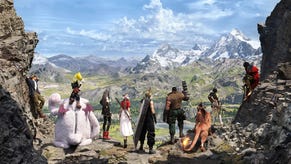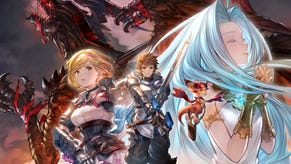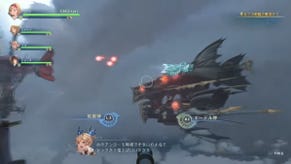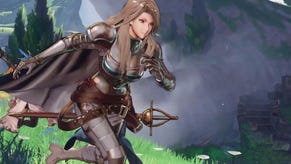Granblue Fantasy: Relink is a striking, impressive cross-gen fantasy RPG
60fps makes all the difference on PlayStation 5.
After a protracted production, a developer swap and several delays, Granblue Fantasy: Relink has finally been released, some eight years after its initial announcement. This is a bold, colourful action RPG that combines compelling storytelling with a bombastic and exciting combat system. It's one of the more original RPG efforts I've seen in a while, but its protacted development raises questions about its visual quality and performance on PS4 and PS5 systems.
Right out of the gate, it's clear that Granblue Fantasy: Relink looks excellent, with beautiful and well-animated cutscenes that are interspersed generously throughout the title. Some of these scenes are more sedate, but many depict grand battles with plenty of pyrotechnics and carefully-animated swordfights. These are some of the best cinematics I've viewed in a while, and the game looks absolutely lavish here. Because Relink is a relatively modest adventure by RPG standards - clocking in at ~15 hours to complete the story and another ~20 to complete optional content - the game takes a liberal approach to cinematic density that few other RPG efforts in recent memory can match.
We also see a good workout for some of the game's key rendering tech here as well. Of particular note is the post-processing, namely the motion blur and depth of field. Relink has extremely high-quality motion blur that makes the game look very smooth in its default performance mode. Even when you examine the motion blur closely, it holds up remarkably well, without the kinds of sampling artifacts that often characterise motion blur techniques. The bokeh depth of field is also used frequently, with an attractive appearance and blurring patterns that suggest a circular aperture.
The character rendering is an obvious highlight in these scenes too. The game's friends and foes lean towards a flat-shaded look, with typical anime proportions in their facial features. They also bear some trademarks of illustration - namely horizontal shading lines in the character texture details. These models look like a mix of the models from Valkyria Chronicles and Tales of Arise, with some of the painterly touches of the former with fidelity closer to the latter.
Those illustration-derived artistic flourishes do extend to the rest of the game if you look closely. Clouds, for instance, which are represented here with 2D art, have a definite painted quality to them. Grass is slightly abstract-looking and flat-shaded, while the texture art has a low-detail flat look with subtle use of normal mapping, giving the game a bit of intentional simplicity in the environments. It's not quite as in-your-face with artistic touches as the aforementioned Valkyria Chronicles, but it feels more confident than a typical stylised RPG effort.
Other key areas of the visuals hold up quite well. The environmental lighting, for example, looks pleasing and is reasonably sophisticated. We see a mix of baked and real-time lighting here, with some signs of light bounce and subtle occlusion in shaded areas. Sometimes on close examination, the lighting doesn't produce a true-to-life result, with a bit of a flat look at times, but overall the lighting is fairly satisfying. For reflections, we see a lot of cubemaps, which can look a bit basic and don't match the environment very well, but do avoid occlusion problems.

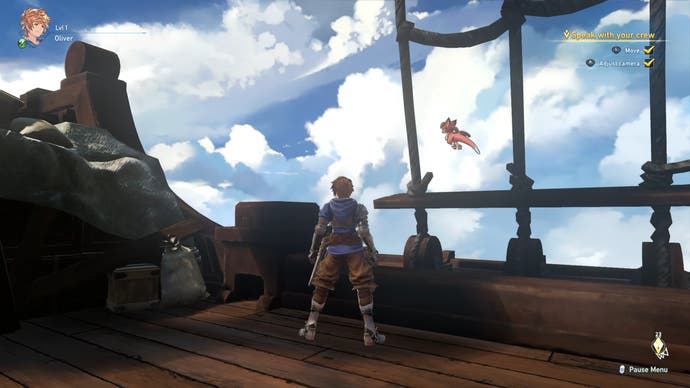
Initially I thought the game might use Unreal Engine 4, which is ubiquitous in similar-looking games like Tales of Arise and Dragon Quest 11, but the lighting didn't quite seem reminiscent of Lightmass, and the post-processing didn't quite give me an Unreal Engine feeling, especially the lack of screen-space reflections. On further inspection, the game lacks any kind of Unreal Engine credit as far as I can see, either in-game or in any materials published online, and a look at the PC version's files doesn't indicate UE4 either. I suspect the title is using a custom engine, perhaps derived from technology developed by PlatinumGames, who were initially co-developing the title with Cygames but left the project in 2019. It doesn't look like any commonly licensed engine I've seen, so some kind of internal technology seems like the most plausible choice.
You do feel the lingering remnants of that PlatinumGames co-development in the game's action sequences. Relink has exciting, visually engaging combat, with fluid animation and satisfying hit effects. These encounters are punctuated by flashy special attacks, which include abilities on a timer, context-sensitive Link Attacks, show-stopping Skybound Arts, and group burst attacks when a number of Skybound Arts are used in quick succession. It leads to a dazzling, and at times slightly disorienting, combat experience, with a constant deluge of high-quality animation and beautiful special attacks.
In terms of the game's basic visual design, I don't have many complaints. We do see some occasional oddities, with some lights not casting shadows on as many objects as they probably should, and shadow resolution tends to be a bit on the limited side, although the shadow filtering produces a decent result in the end. The environments tend to be perhaps a little less geometrically dense than other similar titles as well, and can have a slightly boxy appearance - and again, the baked lighting doesn't always produce great results.
Overall though, the game looks and feels excellent. I didn't come in with super high expectations, but the final game exceeded my presumptions. Granblue Fantasy: Relink is a visual treat, a game that isn't using cutting-edge tech but maintains beautiful stylings throughout.
Relink features two visual modes on PS5 hardware. We have a performance mode which targets 60fps and a quality mode which aims for 30fps. I spent the vast majority of my gameplay time in that performance mode, as the two modes offer similar underlying visual settings and largely differ in terms of resolution. Performance mode has a 1080p resolution, while the quality mode steps up to a full 4K. This is a bigger delta than we typically see between performance and quality modes, with 60fps options in cross-gen software usually clocking in at 1440p or above, so this is a little odd.
In gameplay, the performance mode looks quite a bit duller than its quality counterpart, lacking a lot of fine detail, especially at a distance. UI elements are similarly decimated and clearly lower resolution. The performance mode doesn't look bad by any means and the TAA does a reasonable job keeping aliasing to a minimum, but it's not too well suited to 4K displays, especially at close range. The quality option is quite crisp and stable in contrast.
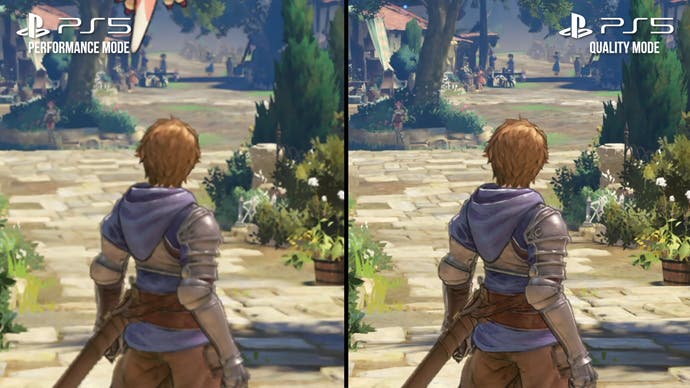
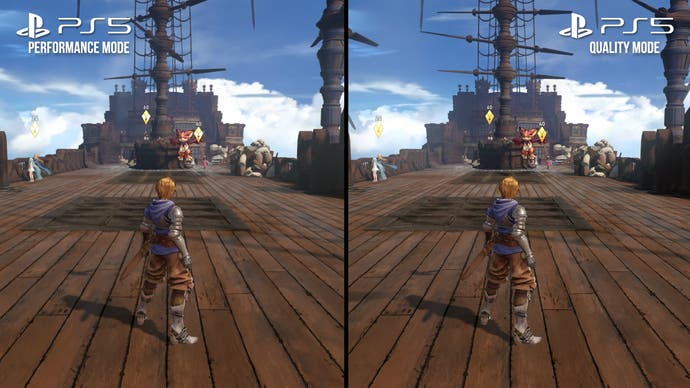
Frame-rates in the performance mode are nearly impeccable. Here, the game runs at a nearly locked 60fps, throughout all gameplay and cutscenes. I did note a couple of minor exceptions - a few moments where the game can drop a frame or two during some open-world traversal - but Relink sticks to a 60fps update almost all of the time and it feels smooth and satisfying as a result.
The quality mode offers a consistent frame-rate as well, albeit targeting 30fps. Unfortunately, the game does have some frame-pacing issues, with a mix of 16, 33 and 50ms frames during more intense sequences, while more sedate moments usually run at 30fps with the occasional 16ms frame sprinkled in. It's definitely not ideal, but the frame-pacing is mostly OK outside of certain combat moments, so it's not as bad as we've seen in other poorly frame-paced games. The motion blur shutter speed is a little too fast for my liking here though, which produces a slightly choppy-looking output.
The last-gen version of the game on PS4 looks similar to the PS5 build, with some lighting differences that suggest simplified indirect lighting. These kinds of tweaks are noticeable throughout the environment and give the PS4 version a less accurate lighting presentation. Assets also appear to be cut-down somewhat, with lower-resolution textures in some scenes. Motion blur has also been completely stripped out of the PS4 code.
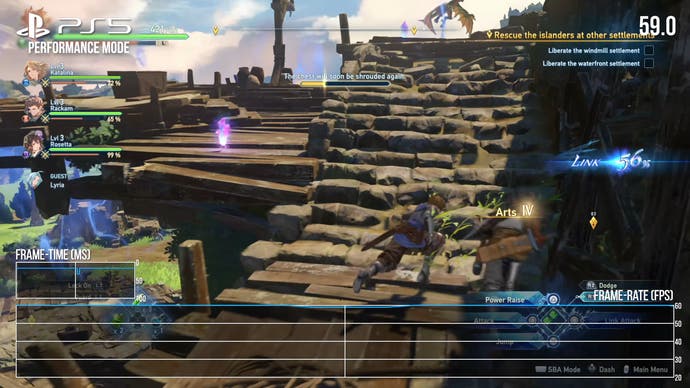

PS4 clocks in at 1080p resolution, which feels about right for the vintage machine. But it does make you wonder a bit about the PS5 version, which despite a mammoth compute and bandwidth advantage over PS4, doesn't manage a higher resolution than 1080p when targeting 60fps.
The PS4 Pro, in contrast, appears to run without any visual enhancements whatsoever over its weaker last-gen counterpart. There are no obvious improvements in basic visual settings, and it clocks in at the same 1080p resolution in the shots I tested. That's pretty disappointing, considering the much higher level of GPU power on the Pro system, which is basically going untapped.
Both PS4 and Pro target 30fps, but the frame-pacing issues from the PS5 version have returned. We see the same pattern of 16, 33 and 50ms frames, except this time the extent of the problem is more severe. The game suffers from near-constant frame-pacing problems on PS4 platforms, giving the impression of a game with a much lower frame-rate. Relink just never feels smooth on last-gen machines.

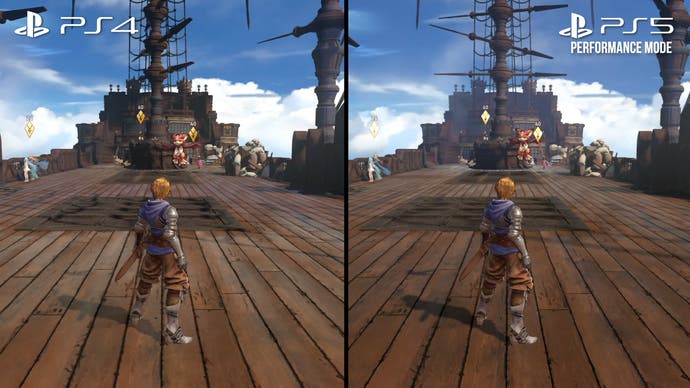
As a game, Relink is an interesting and novel RPG. Generally speaking, you lead one character in a four-person squad, with other characters controlled by AI in single-player. The actual combat is fine enough, based around a few basic attacks and a broad array of special abilities, which work best in combination with other party members. A lot of the time you'll be facing off against powerful boss enemies rather than lower-level enemy groups, with very long encounters against often gargantuan foes. These fights seem to revolve around positioning, with plenty of "don't stand in the fire" mechanics that require the player to avoid telegraphed damaging attacks.
It ended up reminding me quite a bit of MMO-style dungeon encounters that players of World of Warcraft or Final Fantasy 14 might be familiar with, albeit with very different movement and attack mechanics. It really feels like you are just one part of a substantially bigger party, just like in an MMO title. That makes sense, because the endgame seems to be oriented around multiplayer gameplay, where the party structure presumably makes a lot of sense, but it's a slightly odd though not unwelcome fit for single-player.
The last bit of weirdness comes down to the story. Granblue Fantasy: Relink isn't actually an original title - it's a sequel to the 2014 mobile Gacha game Granblue Fantasy. While the story is somewhat self-contained, it does continue from the mobile original with the same world and a similar cast of characters.
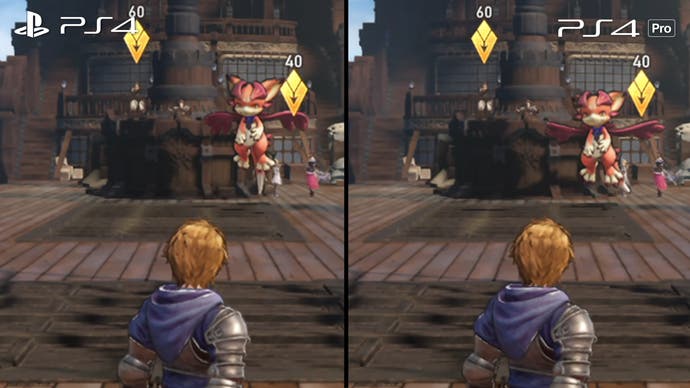
The game presumes you have a good amount of familiarity with the source game, and drops you into the deep end plot-wise almost immediately, with only an in-game atlas to help new players untangle it. I have zero experience and little interest in playing the original mobile title, especially given it wasn't released outside of Japan in the first place.
I'm not one to insist that a game holds your hand if you haven't played its predecessor, but I think this is a unique case where more care could have been taken to bring new players up to speed - if not in-game, then with some kind of video recap. There is a three season anime version of Granblue Fantasy that reportedly does cover a lot of the original game's story, so I'd probably recommend most prospective players start with that. Going in fresh, I was very confused.
Beyond any narrative issues, I did enjoy my time with Relink. The combat is flashy and fun, the production values are very high, and I'm partial to its MMO-style encounter design. The game has a propulsive, plot-pushing structure that I quite liked, with explorable areas that tend to be more directed, with a mix of linear and semi-open gameplay spaces. I also thought the music was superb, and the voice acting was very evocative.

Relink is a visual treat as well, offering a beautifully animated world with bold action combat. My primary visual complaints don't have anything to do with the quality of the underlying graphical work, but revolve around the way the game is configured.
The frame pacing issues, which annoy in the PS5 quality mode and aggravate on PS4 and PS4 Pro, can significantly detract from the experience. I also feel like the PS5 ought to have enough headroom to deliver a higher resolution than 1080p in its performance mode, and the PS4 Pro should similarly be quite capable of running at a higher resolution, better visual settings and/or at a higher frame-rate than the base PS4. Thankfully, the relatively high quality of the basic visual design can overpower those concerns, at least if you're playing on a PS5.
Overall, Granblue Fantasy: Relink is a bold and visually striking action RPG. Players who are looking for a new action title with MMO touches will find a lot to like here, despite the configuration and narrative caveats.



